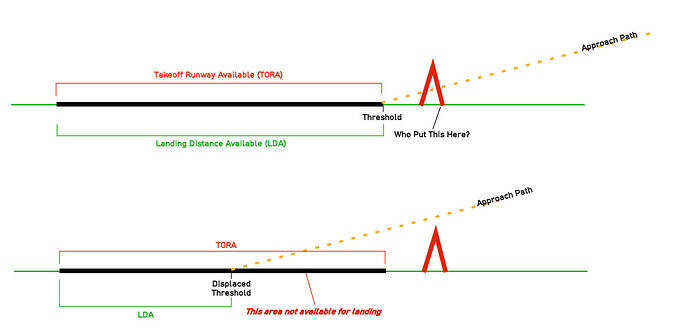You’re correct: the pavement marked with yellow chevrons is not available for aircraft movement. That area is commonly referred to as the “overrun” or the “blast pad.” In the case of KBFL, that pavement was originally part of Runway 30R, but at some time between 1956 and 1968, it was converted to overrun.
Overruns serve three purposes: they provide a solid surface for aircraft that inadvertently overrun the runway during landings and rejected takeoffs, provide an obstacle-free “clearway” for aircraft taking off, and provide a solid area behind aircraft taking off that prevents erosion from jet blast. They may also include EMAS (Engineered Materials Arresting System).
Basically, some regulations require aircraft to cross the departure end of the runway at an altitude no lower than 35 feet above the ground during takeoff. If that same runway has a suitable clearway, then half of the distance to reach 35 feet can include the clearway, meaning the airplane is only required to cross the threshold at 17.5 feet above the ground. This could allow aircraft departing Runway 12L to carry greater payloads.
The displaced threshold–marked by the white arrows along the runway centerline–is something completely different. This area is available only for takeoff in both directions. You’ll usually see a displaced threshold when there are significant obstructions approaching the runway. Like takeoff, there are required clearances in the area approaching the runway for landing. If an immovable obstruction penetrates the required approach path, then the path must be relocated to accommodate the obstruction. Here’s a quick drawing I made that shows what’s happening…
In the top drawing, we see the runway with two declared distances: the Takeoff Runway Available (TORA) and the Landing Distance Available (LDA). The dashed yellow line shows the sloped “surface” that must be clear of obstructions. The massive red obstruction penetrates that approach surface. So…
The second drawing shows the fix. By sliding the approach surface further down the runway, we provide the required clearance over the obstruction. The approximate place where the surface meets the runway becomes the displaced threshold.
Here’s the declared distances for KBFL from the Airport/Facilities Directory…

The TORA for Runway 30R is 10,848 feet, while the LDA is 7,429 feet. In this case, for some reason, the landing threshold is displaced 3,419 feet down the runway. While this is normally done to accommodate obstructions, it’s also possible the threshold was displaced to accommodate the surrounding community and was placed at that location simply because that’s where Taxiway B meets the runway.
Other airports with significant displaced thresholds are San Diego (there’s a massive hill approaching Runway 27) and Chicago-Midway (obstructions everywhere). Many airports have overruns. Those at places like Burbank and Midway include EMAS.
You can read more about declared distances in Wikipedia’s “Runway” article. It’s actually well written!
I hope this helps. Fly safe!


